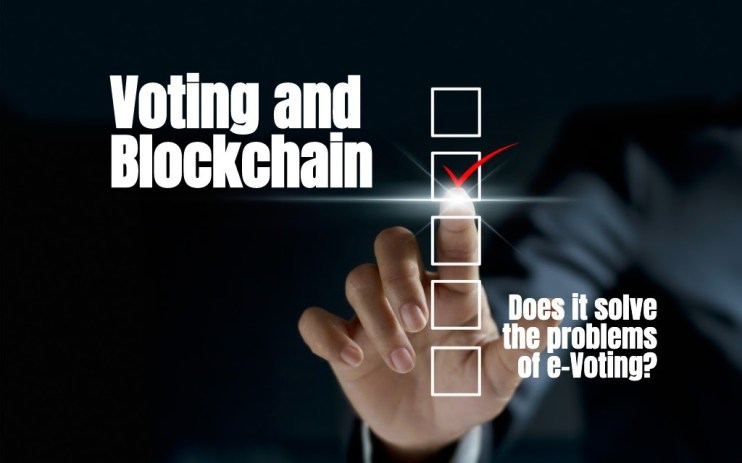Voting and Blockchain

In the days of COVID-19, there are new challenges in participating in democracy. There are unique challenges in how people vote. Traditional polling centres must be equipped to support social distancing. In the US, some cities and states are working to consolidate polling locations. And although there are no imminent elections here in the UK, similar changes will be required here to address issues of public health and safety.
Since 1918 postal voting has been possible for service personnel unable to vote due to the nature of their position. In 1948, regular citizens could vote by post. And according to an NBC/Wall Street Journal poll in April 2020, 58% of Americans believe that everyone should be allowed to vote by mail, primarily due to the threats arising from COVID-19.
There are issues and challenges with postal voting related to the potential for fraud as well as the administrative overhead of verifying signatures and lost or nullified ballots.
Beyond postal voting, there have been numerous attempts to implement electronic voting at polling places and via mobile applications. The stories of errors and inconsistencies in digital data have created a severe urge for caution in trying to move too far too fast into the digital age.
But what role might blockchain technology play in the future of voting?
Voting has been part of blockchain technology since Ethereum was launched in 2015. Many early blockchain projects allowed for voting by community members and token holders through blockchain to help decide the direction of the projects. An advanced concept of a distributed autonomous organisation (DAO) has no official leader. Community votes make decisions on the blockchain. Blockchain records these votes and tallies the result. But what makes blockchain the right choice?
The blockchain system would only assure a) that any individual would only vote once and b) that the network agreed to the tally of votes.
A public permissionless blockchain has three core characteristics: The data written onto the ledger is immutable (tamper evident), the system is distributed (multiple copies of the data lending itself to high-availability) and the system is decentralised (no single entity or group are in control).
A critical design step is deciding what data to store on the blockchain. Applying a principle of Minimum Effective Blockchain (MEB) the only data on the blockchain would be recording that a particular citizen had cast a vote and the tally or cumulative sum of the votes. Entries on the ledger would not contain any personal information, nor would they include the specific details of how a person voted.
The blockchain system would only assure a) that any individual would only vote once and b) that the network agreed to the tally of votes.
Blockchain systems provide maximum value when there are multiple distrusting parties all agreeing to reference a single source of truth. In this case, there are most undoubtedly various distrusting parties. Different political parties do not trust one another. Many voters do not trust governments. And some voters do not trust one another.
There must be a simple explanation of how the system works to achieve acceptance of blockchain for voting. And the system must be open to audit and inspection by anyone.
So far, so good. Now we come to the challenges – and there are more than just a few.
Citizens must be registered to vote. Each citizen must be issued a unique token to vote on the blockchain. Voter registration agencies would be responsible for issuing these tokens and ensuring that no one was issued more than one token. The voter is responsible for managing their token and for keeping it safe. The agency is responsible for protecting the personal information of the voter and keeping that data safe.
Just as with postal votes, the agency must have a method to validate the signature of the vote. In a blockchain, this is done with cryptography using public and private keys. The blockchain network (the computers managing the ledger) utilises public and private keys to verify the authenticity of each vote, without verifying the identity of the voter.
The blockchain network utilises public and private keys to verify the authenticity of each vote, without verifying the identity of the voter.
Security experts are rightly concerned with protecting these digital signatures. This is true of all forms of electronic voting – both blockchain and non-blockchain. Various levels of biometric security (facial recognition, fingerprint verification) are available, and none are without their problems.
Once in the digital world, there are also concerns about malicious software on people phones or computers. Malicious software could attempt to read people’s votes, capture their identity or even change their votes.
And yet, society has rapidly moved to adopt digital banking, mobile banking, contactless payments and even online digital identity services like those from Estonia. Each of these systems has evolved and put in place security measures sufficient to earn the trust of a majority of consumers. Electronic voting solutions can be built at least as securely as online and mobile banking.
Other e-voting systems are based on a centralised architecture which is subject to direct attack by malicious third parties.
Creating a blockchain ledger can prevent multiple votes from a single person. It can avoid attempts by one person attempting to appropriate someone else vote fraudulently. And blockchain can securely and accurately record the tally of votes in a way that is auditable and visible to all. Blockchain can achieve this through its properties of being decentralised, distributed and immutable.
A frequent challenge when discussing blockchain is in making clear the problem blockchain solves. In the case of voting, a blockchain-based ledger and associated network solve the problems of data integrity, transparency and security. Blockchain has never claimed to address the challenges of identity, device security or ease of use.
Whether electronic voting happens via email, web, mobile app, there are issues to be addressed. Blockchain technology is secure, mature and available as a superior solution when it comes to storing the data in a way that ensures trust in the democratic process.

Get in touch with us info@blockchainrookies.com / Twitter @igetblockchain
Troy Norcross, Co-Founder Blockchain Rookies